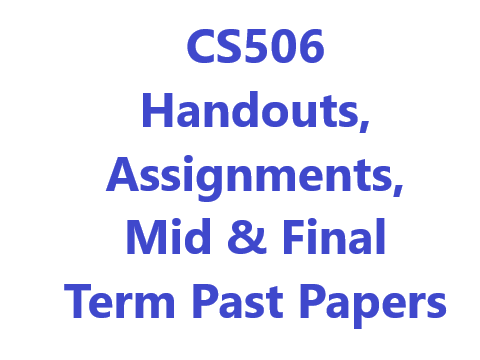CS506 Handouts, Assignments, Mid & Final Term Past Papers are given below. There are two modules in the course. Java’s foundational concepts are covered in the first module along with some more advanced topics like Graphical user interface, Java Data Base connectivity, Java Graphics, Socket programming, Serialization, and Multithreading. Java Server Pages, Java Beans, Servlets, and JSF (Java Serve Faces) are covered in the second lesson, which is all about creating web applications. JDK 1.8, Tomcat server 9.0.0, and NetBeans IDE 8.2 are the tools used in this course for Java programming and web application development.
Java is quite resilient. both against unintentional errors and against malicious applications like viruses.
o Java’s performance slightly declines as a result of all this inspection. (Alternatively, it may be faster as C doesn’t perform any checks.) When the code loads, the JVM’s “verifier” checks it to make sure it has the right structure and doesn’t use mix pointers or uninitialized pointers. This is a “static” analysis that is performed once to confirm that the code is structured correctly without actually running it.
To ensure that some actions, such as pointer and array access, are only touching the proper memory.

CS506 Handouts, Assignments, Mid & Final Term Past Papers
The JVM additionally does “dynamic” verification during runtime. You’ll create code that crashes. Java is hence immune to many common bugs and security problems (like “buffer overflow”). The checks also make it easier to find common issues because the runtime checker finds many of them. Generally speaking, you will never write code that fails the verifier since your compiler is intelligent enough to produce only right code. You will frequently write code when debugging that runs into runtime errors like array out of bounds and null pointer
Java’s Runtime Security!CS506 Handouts
Furthermore, Java has a runtime security manager that may check the permissions of individual pieces of code. Java handles untrusted code in a “sandbox” where it can render to the screen but cannot access local data as a result. A program written in C++ is referred to as source code. This source code is transformed into the machine code of the underlying system (such as Windows) by the C++ compiler. You must recompile the code using a Linux-based compiler if you want to run it on Linux.
You may need to adjust your code from time to time because of the variations in compilers.
Write Once, Run Anywhere (WORA) is a concept that Java has introduced. The source code of Java is what you use when writing a Java program. Rather than producing this source code for any underlying hardware system, the Java compiler produces it for a software system known as JVM (the produced code is referred to as byte code).We use many JVMs for
Lesson Learning Objectives:
Upon finishing this course, you should be capable of:
-
Describe a few basic and advanced Java principles.
- Create a Java graphical user interface.
- Create or design a corporate web application.
- Explain the various Java technologies.
- Differentiate the various Java technologies.
-
know how to apply a specific technology in a specific scenario.
Phase 4: Before the Java interpreter runs an application’s byte codes, the byte code validator verifies them. This guarantees the validity and compliance with Java security constraints of the byte codes for classes that are loaded via the internet (also known as downloaded classes).Java enforces strong security because, unlike computer viruses, programs written in Java shouldn’t be able to damage your files or system. Phase 5 is the last step, during which the computer interprets the program bytes at a time under the direction of its CPU. so carrying out the program’s instructions. A program may not operate properly the first time it is run.
There are several reasons why the earlier stages could have failed. As a result, the Java program would produce an error message. After making the necessary corrections, the programmer would go back to the edit phase and repeat the following phases to see if the changes were successful. This handout’s whole material was taken from JAVA A Lab Course by Umair Javid.
This information may only be used by VU students enrolled in the Web Design and Development course; it may not be used for any other commercial purpose without the author’s permission.
The program starts on line 5, declared exactly for Java interpreter to run. The parameter supplied to main may have a different name. In C++, main() is global and outside classes. Java doesn’t have global variables or functions. We’ll talk about the essential elements of a function declaration later.
CS506 Handouts:
There are handouts on the linked page “CS506 Handouts“.
CS506 Past Papers:
CS506 Midterm Past Papers:
There are Midterm Past Papers on the linked page “CS506 Mid Papers“.
CS506 Final Term Past Papers:
Final Term Past Papers will becoming soon.
CS506 Assignments:
CS506 Assignments will be coming soon.